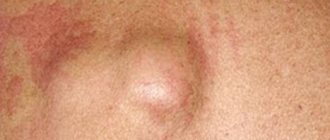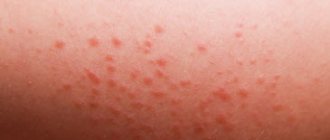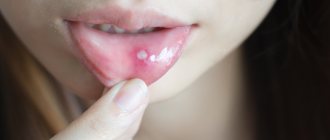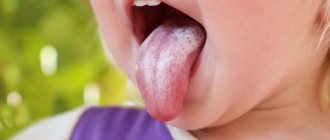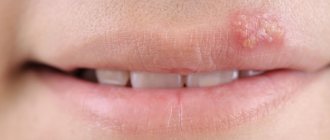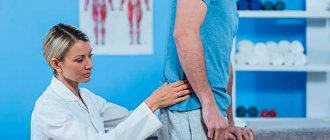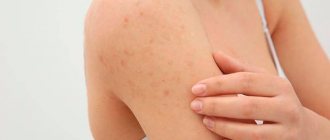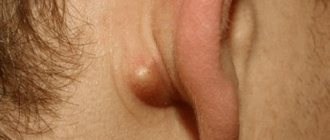Clinical picture
Skin rashes (pimples) occur due to blockage of the ducts of the sebaceous glands. The disease manifests itself as:
- small scarlet pimples;
- white dense formations;
- watery transparent blisters;
- large seals.
When scratched, the skin at the site of the rash becomes dry, can become inflamed and peel, and scars and ulcers form on its surface. People of any gender and age are susceptible to pathology.
Ignoring symptoms can lead to infection of the inner layers of the epithelium and sepsis.
How to get rid of acne on thighs
Treatment of rashes includes a set of measures aimed at eliminating the cause, symptoms and prevention. Treatment methods depend on the form, severity and prevalence of pathological manifestations. For mild forms, external therapy is used; for moderate and severe forms caused by immunopathological and infectious diseases, systemic therapy is prescribed.
Treatment includes a set of measures:
- Diet . The diet includes more vegetables, fresh fruits, nuts rich in vitamins and minerals.
- Proper hygiene. In hot weather, showers are taken more often; preference is given to natural hypoallergenic cosmetics.
- Use of oral medications : antibiotics, antihistamines, antiparasitics.
- Use of products for external use. Prescription drugs must be prescribed by a doctor.
- A course of hormonal medications.
- Traditional methods.
Be sure to read:
What does a pimple on the forehead mean: folk signs
You should reconsider your wardrobe in favor of spacious clothes made from cotton or linen fabrics. Try to avoid stress, it negatively affects the immunity of the epidermis.
Medicines and cosmetology
Regardless of the reasons, external pharmaceutical agents are used to eliminate the rash:
- retinoids relieve inflammation, normalize keratinization processes and the functioning of the sebaceous glands: Radevit, retinoic ointment;
- antiseptics suppress the growth of pathogenic flora, cleanse pores, eliminate itching: Verrucacid solution, boric acid, Formagel;
- dermatotropic agents relieve itching, irritation, and are also prescribed for skin diseases: Naftaderm, Retasol solution;
- antibacterial drugs: Differin, Clindamycin phosphate;
- antiparasitic agents are used for damage by ectoparasites (external): Benzyl benzoate, Spregal aerosol.
After eliminating the cause and in the absence of purulent rashes, you can use special cosmetics:
- Normaderm cleansing lotion (Vichy);
- Blue Astringent Herbal Lotion (Kiehl's);
- exfoliating body scrub (Vitex);
- cleansing cream-scrub (L'Cosmetics).
Cosmetics can be used for preventive purposes.
Traditional methods
Traditional methods also help to get rid of rashes on the thighs and buttocks. They include a whole range of different tools and procedures. Homemade formulations contain natural ingredients and are considered safe, however, their use should be discussed with a doctor. It is advisable to combine traditional methods with traditional treatment.
- Baths with herbal decoctions. Chamomile and calendula are poured with boiling water, the strained solution is added to the bath.
- Washing affected areas with tar soap. The procedure is carried out once a day.
- Cosmetic clay masks. Mix blue or green clay with water until a creamy mass is formed. The composition is applied to the affected area for 20 minutes, washed off with warm water.
- Homemade scrubs. Coffee beans are ground in a coffee grinder. Mix tbsp. l. ground grains from tbsp. l. sour cream. The resulting composition is distributed with massage movements and washed off after a quarter of an hour.
Be sure to read:
How to remove irritation in the intimate area: why white pimples appear after shaving
It is recommended to alternate home methods.
Reasons for appearance
There are many reasons why acne appears on the back, front, inner and outer sides of the thigh. Skin rashes are caused by a variety of factors. They may be:
- hyperhidrosis (excessive work of sweat glands);
- inflammatory process occurring in hair follicles;
- hormonal changes during the period of active sexual development;
- allergic reaction to the cosmetics used;
- insufficient adherence to personal hygiene rules, skin contamination;
- lack of air (poor breathability of clothing);
- underwear made from non-natural (synthetic) fabrics.
Factors that increase the risk of disease:
- vitamin deficiency, poor nutrition;
- diseases of the gastrointestinal tract;
- weakness of the immune system;
- parasitic and viral infections;
- drinking water of poor quality;
- sudden change in climatic conditions.
Increased sweating
Occurs as a response to overheating of the body in the summer under the influence of high temperatures or due to unjustified wrapping of the limbs while in a warm room. This is how the body tends to cool down faster. Frequent washing and selection of loose-fitting trousers and dresses made from natural, breathable fabrics (linen, viscose, cotton, wool) will help reduce sweating in the heat.
Folliculitis
Develops as a result of incorrectly performed depilation of the legs. As a result of such manipulation, hairs grow into the skin, the process is accompanied by pain, redness in the problem area, and burning.
Acne or acne
It develops during the active release of sex hormones during the maturation of the body. The area of the face, back, buttocks, thighs, and genitals is often affected.
Cosmetics and household chemicals
Aggressive substances contained in washing powders, shampoos, creams and soaps can lead to an allergic reaction. Allergies can also be caused by the presence of individual intolerance to the constituent components of cosmetics and detergents.
Acne due to various diseases
Often, rashes on the lower extremities are a consequence of various pathological processes occurring in the body.
If acne appears on your thighs, it may be a sign of one of the following diseases:
- Genital herpes. You can become infected with it in public places or through skin-to-skin contact with a sick person. Watery pimples appear in the groin area and on the inner thigh. This disease does not go away on its own; treatment will be required to avoid serious consequences.
- Allergy. The reaction is expressed in multiple rashes of small red pimples. Allergies to food, synthetic clothing or detergents may occur. You should consult a specialist to identify the allergen.
- Molluscum contagiosum. This is an infectious disease transmitted through the skin. Getting rid of this parasite can take quite a lot of time and effort.
- Dyshidrotic eczema. The appearance of a rash is triggered by skin contact with household chemicals. It is likely that eczema will occur due to mild poisoning from hazardous work.
- Dermatitis. The disease manifests itself as small watery pimples, severe and constant itching. Occurs due to wearing tight clothing, as well as upon contact with chemically active substances or after taking antibiotics.
Sometimes acne is caused by taking anabolic drugs. Rash on the lower extremities occurs in men who take steroids to build muscle mass. These drugs cause pore closure, suppuration and inflammation. To restore the functionality of the pores, it is necessary to stop taking anabolic steroids.
Acne can often appear due to disruptions in the hormonal system. This is typical for adolescents during puberty and for women during pregnancy.
Treatment
You can get rid of acne on your skin on your own. But to avoid side effects and unwanted manifestations, you should definitely consult a specialist.
Medicines
Medicines and cosmetics against rashes are prescribed in accordance with the established diagnosis.
The following medications are prescribed:
- "Zinerit";
- "Dalacin";
- Vishnevsky ointment;
- zinc or sulfur ointment (if there are ulcers),
- gel "Skinoren";
- vitamin complexes;
- streptocidal ointment, Amoxil (antibiotics used for inflammation);
- antihistamines (Suprastin, Zyrtec, Zodak) and non-steroidal anti-inflammatory drugs;
- antiseptic lotions, tonics.
Advanced pimples and severe acne are removed using liquid nitrogen. Such manipulations are carried out only in specialized clinics.
Folk remedies
Traditional medicine helps to cope with acne. Effective are:
- Tincture of calendula, chamomile (you can add coltsfoot), aloe juice: they rub the skin in the affected areas.
- Tar soap.
- Turmeric: powder is mixed with vegetable oil in a ratio of 8:5, applied to the problem area. The procedure is carried out every day until complete recovery.
- Garlic. Its juice is used to treat pathological neoplasms. You can make a mask by applying chopped garlic paste to the painful area, previously lubricated with olive oil.
- Sea salt. Warm salt baths are recommended to be taken daily: they soften and soothe the skin.
- Lemon juice, tea tree extract.
- Fir oil.
- A scrub made from shower gel and table salt. Used if there is no inflammation. As a solid component, you can take coffee or ground oatmeal.
- Linen masks: the product is mixed in water until thick, painful areas are lubricated with it, left for a quarter of an hour, then washed off.
Effective home remedies
- Use substances containing salicylic acid (salicylic ointment). You can try local antibiotics (“Dalacin”, “Zinerit”, etc.). However, be careful, these drugs dry out the skin very much. If after 10 days the skin peels and the rash does not go away, then it makes sense to consult a dermatologist.
- If the pimples resemble a rash, then to treat it you can wipe your feet 2 times a day with a decoction of chamomile or calendula.
- You can mix glycerin and acetylsalicylic acid powder in equal proportions. This mixture should be smeared on problem areas.
- Monitor the room temperature. It should be 23-24 degrees. This will reduce sweating, which causes clogged pores. If you carefully monitor the room climate, sweating will quickly return to normal. This is important, since most of the toxins and waste are eliminated through the skin.
- Products containing chlorine are also dangerous. It is found in many household chemicals, detergents and cleaning products. You need to use hypoallergenic washing powders; they are much less harmful to the skin.
- Take vitamin A. There are a lot of such drugs at the moment. Retinol has an excellent effect. But these medications must be taken under the supervision of a doctor, as large doses can lead to serious consequences.
- Try rubbing your skin with salt.
- Effective treatment of rashes on the legs using ozone therapy. This procedure is used in combination with a variety of medications. Thanks to ozone therapy, the blood is enriched with oxygen, and the absorption of trace elements of a healing nature into the body improves. This significantly speeds up the healing process.
How to prevent the spread
To prevent acne from spreading to other parts of the body, the following mandatory rules should be followed:
- constantly take a shower and perform water procedures;
- change underwear daily, wear clothes made from natural materials;
- use only clean and individual bedding and bath accessories;
- take air baths regularly;
- wear loose, breathable clothing;
- if you sweat heavily, you can use baby powder;
- after completing peeling and scrubbing, disinfect the skin surface with a chlorhexidine solution;
- take herbal baths based on chamomile, St. John's wort, calendula (you can apply ice to the affected areas);
- eat right: eat fruits and vegetables, exclude flour, sweets, soda; drink plenty of water.
To completely remove acne, you need to eliminate the factor that caused it.
Reaction to shaving
Getting rid of hair on the legs is a fairly common procedure among the fair sex. After shaving, your legs look much more attractive. But such a process can cause profuse rashes if not treated with due attention.
When shaving, the following rules must be observed:
- You can only use a clean and new machine. It is desirable that its head be floating. Do not allow other people to use the razor. You must first treat the blades with medical alcohol.
- The legs must be thoroughly steamed. This is required for the hairs to become soft. In this state, they are much easier to cut with the blades of the machine.
- Before shaving, the skin must be lubricated with a special gel that creates a sliding effect. It is better not to use soap and cream.
- You should shave your legs in the direction of hair growth. If you do the opposite, there is a high probability of the blades cutting off pieces of skin. The result will be the appearance of wounds and pimples.
- You should not rub your legs with a washcloth after shaving.
- Legs must be treated with lotion after shaving. It is advisable not to wear tights or trousers for several hours. You should choose the right cosmetic skin care products.
If acne still appears despite precautions, then it is necessary to use other methods of hair removal.
READ ALSO: Hormonal acne: causes, diagnosis and treatment
Prevention
Preventive measures to prevent the appearance of acne on the thighs in women and men are to:
- keep the body clean at all times;
- in case of severe sweating, especially in summer, it is necessary to perform water procedures several times a day;
- wear loose, ventilated natural clothing;
- Healthy food;
- regularly eat fresh vegetables and fruits;
- Avoid infections and contacts with people suffering from this pathology.
It should be remembered that pimples on the thighs can be an indicator of diseases of the internal organs. To exclude the presence of skin pathologies and the possibility of developing serious complications, when the first alarming signs appear, you should consult a dermatologist.
Incorrectly selected clothes and shoes
This is the most common cause of rash on the lower extremities. Many people, especially women, prefer to wear synthetic underwear. This is equally harmful both in winter and in summer. Synthetics create a greenhouse effect, causing sweating. At the same time, artificial fabric does not absorb moisture. Pores become clogged with fat and subcutaneous inflammation occurs. Hard white bumps appear on the legs.
Another cause of unpleasant rashes is shoes. This is more common for women who wear high boots. Shoes made of fur or artificial leather do not absorb moisture at all, which leads to severe irritation of the skin.
Even the right clothing can cause severe skin irritation. Sebaceous secretions that settle on the tissue serve as a breeding ground for the development of pathogens. The friction between the tissue and the skin allows bacteria to easily penetrate the pores, creating pockets of infection and inflammation.
For obese people, chafing on the inner thigh is common. The reaction to this is redness and rashes. To avoid this, you need to select underwear individually.
Allergies and lack of hygiene
A simple allergy can also lead to a rash. This is the case when it is very important to identify the source in order to subsequently eliminate contact with it. The causes of irritation may be:
- foot cream;
- scrub;
- lotion;
- peeling;
- tonic and much more.
The appearance of acne in the thigh area is quite possible due to poor nutrition. This attack can occur after eating food:
- salty;
- sweet;
- fried;
- acute.
An unbalanced diet can cause rashes.
With an unbalanced diet, the body can be clogged with toxins. If a person suffers from constipation, then the skin partly helps remove waste products. In this case, the dermis becomes grayish in color, and intense pimples appear on its surface. Using a procedure such as colon hydrotherapy:
- the body is cleansed of toxins;
- the dermis becomes clean;
- the headache stops;
- the feeling of fatigue disappears.
Pimples that appear on the thighs may indicate insufficient hygiene procedures. The skin of the feet needs regular cleansing of:
- dead particles of the epidermis;
- sweat and fat secretions;
- mud.
